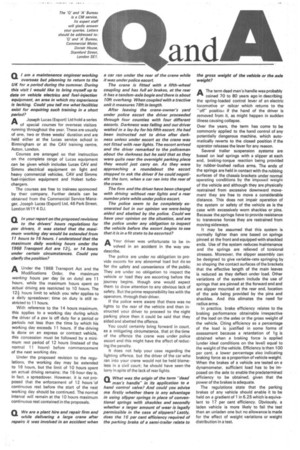Q What was the origin of the term "dead
Page 45

If you've noticed an error in this article please click here to report it so we can fix it.
man's handle" in its application to a hand control valve? And could you advise me firstly whether there is any advantage in using slipper springs in place of conventional springs with shackles and secondly whether a larger amount of wear is legally permissible in the case of slippers? Lastly, does the 16 per cent efficiency required of the parking brake of a semi-trailer relate to the gross weight of the vehicle or the axle weight?
AThe term dead man's handle was probably
coined 70 to 80 years ago in describing the spring-loaded control lever of an electric locomotive cr railcar which returns to the "off" position if the hand of the driver is removed from it, as might happen in sudden illness causing collapse.
Over the years, the term has come to be commonly applied to the hand control of any potentially dangerous machine, which automatically reverts to the closed position if the operator releases the lever for any reason.
Several trailer suspension systems are based on leaf springs with a slipper at each end, braking-torque reaction being provided by rubber-bushed radius arms. The ends of the springs are held in contact with the rubbing surfaces of the chassis brackets under normal operating conditions by the imposed weight of the vehicle and although they are physically restrained from excessive downward movement they are free to move a considerable distance. This does not impair operation of the system or safety of the vehicle as is the case with excessively worn shackles or pins. Because the springs have to provide resistance to transverse forces they are restrained from moving sideways.
It may be assumed that this system is normally lighter than one based on springs pinned at the front and equipped with shackled ends. Use of the system reduces Maintenance and the springs are relieved of torsional stresses. Moreover, the slipper assembly can be designed to give variable-rate springing by so shaping the contact surfaces of the brackets that the effective length of the main leaves is reduced as they deflect under load. Other variations of the system include the use of springs that are pinned at the forward end and are slipper mounted at the rear end, location of the axle being provided by the pins and shackles. And this elimates the need for radius arms.
In practice, brake efficiency relates to the braking performance obtainable irrespective of the load on the axles or the gross weight of the vehicle. Citing efficiency as a percentage of the load is justified in some forms of assessment because a retardation of 1 g is obtained when a braking force is applied (under ideal conditions on the level) equal to the weight of the vehicle. Efficiency is then 100 per cent, a lower percentage also indicating braking force as a proportion of vehicle weight. When the brakes of a vehicle are tested on a dynamometer, sufficient load has to be imposed on the axle to enable the predetermined efficiency to be obtained, given that the power of the brakes is adequate.
The regulations state that the parking brakes of any vehicle should enable it to be held on a gradient of 1 in 6.25 which is equivalent to 17 per cent efficiency. Obviously, a laden vehicle is more likely to fail the test than an unladen one but no allowance is made for the effect of weight variations or weight distribution in a test.




























































































